
Bicycle Chain Cleaning and Lubrication
Unbiased Information on Bicycle Chain Cleaning and Lubing
Last Update: 2 December 2013
This is a non-commercial site. No products are sold on this site.
Introduction
Chain cleaning and lubrication are two very contentious topics among cyclists. Some cyclists spend an inordinate amount of time and money on chain maintenance for no real benefit, other than it makes them feel good to believe that they are doing something good for their chain. Recreational chain maintenance takes time away from actual riding. Worse, some methods of chain cleaning and lubrication neither clean, nor lubricate, but have a following nonetheless. In fact, many of the chain cleaning methods that are in use actually damage the chain.
The bottom line is that the best products for cleaning and lubricating bicycle chains are the simplest and cheapest, kerosene or mineral spirits to clean, and chainsaw oil or foaming chain lube to lubricate. Don't waste money on fancy cleaners and lubricants.
Above all, never clean your chain with water-based cleaners, and don't use hot wax as a chain lubricant (because it isn't one!). By using commonly available, inexpensive products, you can spend a minimum amount of time and money on chain maintenance, and achieve superior results in terms of lubrication and chain life.
Personally, I have a lot of bicycle chains to maintain, not only in my own immediate family, but chains on the bicycles of extended family, as well as of friends of my kids. I have to use efficient. cost-effective, and time-effective methods of chain maintenance.
Cleaning a Chain on the Bike
What's Needed
Kerosene and Mineral Spirits are Extremely Flammable! Use Caution!
Process
What About the Dirty Solvent?
Why is this method the best?
Note that early chain-cleaning tools were rather messy, but newer models are vastly improved.
Cleaning a Chain off the Bike
If you plan to clean your chain off the bike, you should install a Craig Super Link III on your chain. This will speed the process as well as ensuring that your chain does not develop weak spots. These are available from Lickton's and some bicycle shops. As Sheldon Brown writes, "If you wish to make a habit of cleaning your chain off-the-bike, the best approach is to buy an aftermarket master link, such as the Craig Super Link or SRAM PowerLink ."
What's Needed
Warning: Kerosene and Mineral Spirits are Extremely Flammable! Use Caution!
Process
What About the Dirty Solvent?
Why is this method good?
The downside of this method is that it requires removal of the chain, it doesn't clean quite as well, and it takes longer than using an on-bike chain cleaning tool.
How NOT to Clean a Chain
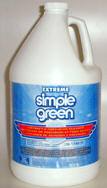
Lubricating a Chain on the Bike, Method 1
What's Needed
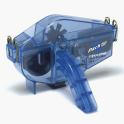


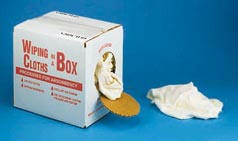
Process
Why is this method the best?
Lubricating a Chain on the Bike, Method 2
What's Needed

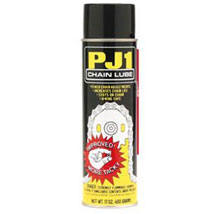 or
or
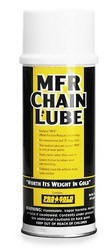 or
or
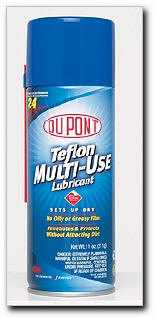

Process
Why is this method good?
Lubricating a Chain off the Bike
What's Needed



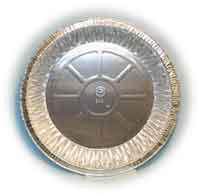
Process
Why is this method good?
How NOT to Lubricate a Chain
What the Experts say About Chain Waxing:
"When wax was popular, we'd get customers coming in all the time complaining about shifting problems on their bikes. Removed the wax and lubed with conventional stuff and voila, shifting back to normal." Mike Jacoubowsky, co-owner of Chain Reaction Bicycles.
"Wax is not mobile and cannot return to a location from which it has been removed by rotation of one part on another." Jobst Brandt, author of The Bicycle Wheel
"If you use dry lube or wax, follow product directions and use it often. In some cases, dry lube should be used for every ride. It wears off very quickly and no new lube can flow to the critical wear areas." Craig Metalcraft, manufacturer of Super Link III.
"Downsides of the wax approach include the fact that it is a great deal of trouble, and that wax is probably not as good a lubricant as oil or grease." Sheldon Brown
Note: If you insist on waxing, be sure to do it properly and safely. Buy a small roaster (about $30) to heat the wax. You must submerge the chain until the metal of the chain reaches the same temperature of the wax. Do not attempt to wax your chain using any method other than dipping. Setting your house on fire is not a good plan. Wax your chain often, preferably after every ride.
What about all those fancy chain cleaners and lubricants?
There is no advantage in using these expensive products over simple solvents and lubricants; don't waste your money. If on tour, a small bottle of Phil's Tenacious Oil is convenient, though less effective than submerging the chain in oil, or using foaming chain lubricant. The various chain products do provide some level of amusement. I think my favorite is "Bike Butter."
It's easy to go into business selling chain lubricants. Just buy some small bottles and fill them from five gallon bottles of industrial lubricants. Create a fancy name, and convince bicycle shops to stock your product.
What about molybdenum and Teflon based dry lubricants?
I tried these back in the 1970's with poor results. However "DuPont™ Multi-Use Lubricant with Teflon® fluoropolymer" seems like it has solved the problems of the original molybdenum disulfide products. It's also very inexpensive. The key question is how well it penetrates into the links and rollers.

Myths and Facts about Chain Cleaning and Lubrication
Cleaning
Myth: Simple Green is a great chain cleaner.
Fact: Simple Green is corrosive and should never be used on chains.
Supposedly, a newer Simple Green product,
Extreme Simple
Green, is safe for chains. However the statement on their web site, "We’ve
found no other aircraft-approved product on the market that matches Extreme
Simple Green’s cleaning performance," is a bit disconcerting, as that sort of
marketing invariably means that they haven't actually tested it against other
products.
Lubrication
Myth: Adding graphite to wax solves the issue of wax not providing
lubrication.
Fact: Graphite is corrosive and should not be used on chains.
Myth: Paraffin wax is an ideal lubricant because it doesn't attract
dirt.
Fact: The second part of that statement is true. But paraffin is not a
lubricant for chains because it isn't fluid. Once it's scraped away by the two
parts rubbing against each other, it doesn't flow back to the load bearing
surfaces. Wax is more of a protective layer, which is why it is effective at
keeping a chain clean. No one that knows anything about chains believes that wax
is a lubricant.
Myth: I wax may chains and I get good chain life. This proves that wax
is an effective lubricant.
Fact: It's important to separate the issues of chain life and
lubrication. A clean chain will last a long time, even if improperly lubricated.
Myth: You can wax a chain by heating the chain and dripping hot wax on
it.
Fact: If you insist on using wax, the only way to do it right is to
submerge the chain into molten wax for several minutes. Preheating the chain
prior to submerging it in the molten wax will shorten the submersion time. Using
a torch has two disadvantages. First, the wax doesn't penetrate into the links
and rollers. Second, dirt is not flushed out of links and rollers.
Myth: Chain life is the sole indicator of a lubricant's effectiveness
Fact: Chain life is partially based on keeping contaminants out, which
hot dipping in wax is effective at doing. However to many riders a lubricant
that is effective in reducing friction is also important. As long as the
fact that wax isn't a lubricant and the downside of not having a lubricated
chain are understood, then waxing by hot dipping is fine.
Other Web Sites on Chain Maintenance
Chain Maintenance by Sheldon Brown
Chain Maintenance by Jobst Brandt
I do take issue with Jobst's
"Primitive rule #1: Never oil a chain on the bike." In my extensive experience,
of cleaning chains both on and off the bike, I have found no advantage to
cleaning it off the bike. In either case you must change the solvent several
times (until it runs clean) to avoid suspended dirt and grit from
re-contaminating the chain. While some solvent does escape from the chain
cleaning tool onto whatever you have under the tool (one of those big metal or
plastic trays used to catch leaks from vehicles works well), it isn't really
messy if you do it right, plus you use less solvent. Unless you have installed a
Superlink III or an SRAM PowerLink, don't remove your chain to clean it.
Chain & Lube Maintenance by the manufacturer or the Superlink III (this is the Wayback machine version, as the original site is gone, thanks to a reader for letting me know about this)
© 2013, The Nordic Group
Send comments to chainexpert@nordicxxxgroup.us (remove xxx). I strive to provide accurate information on these informational web sites. Corrections and clarifications are gladly made.